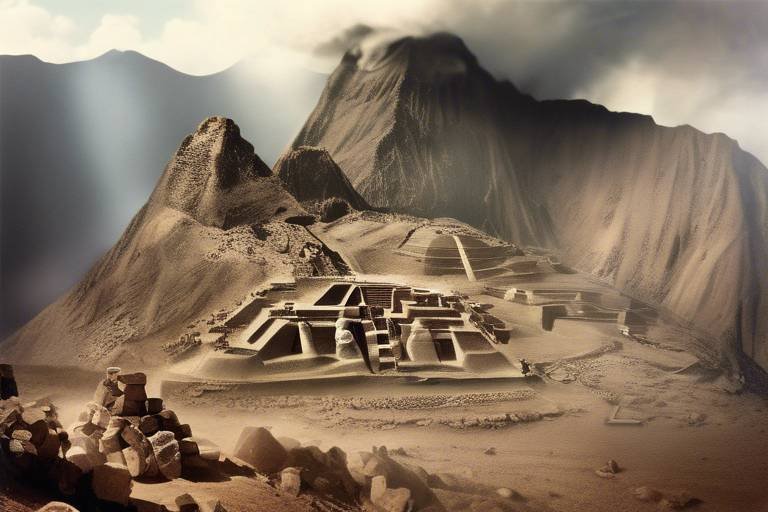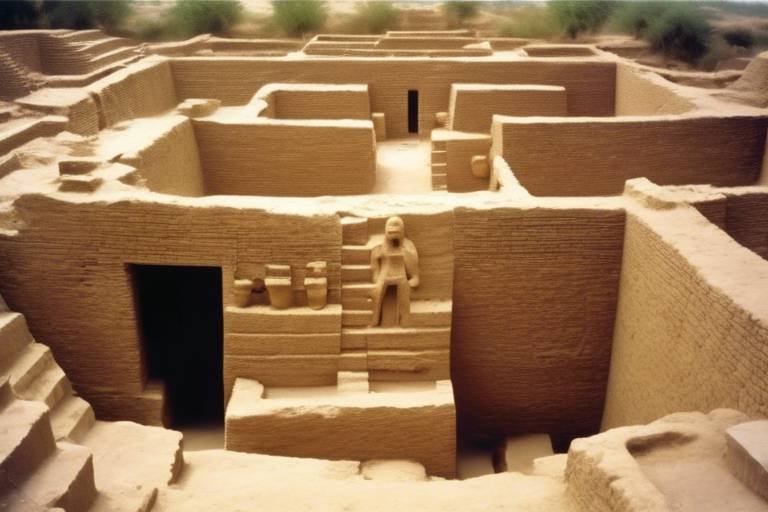The Forgotten Achievements of the Maya
When we think of ancient civilizations, the Maya often take a back seat to more well-known societies like the Egyptians or Romans. However, delving deeper into the history of the Maya reveals a treasure trove of remarkable accomplishments and contributions that have been overshadowed by their more famous counterparts. From awe-inspiring architecture to advanced writing systems, the Maya civilization left a lasting legacy that deserves recognition and appreciation.
One of the most striking aspects of Maya civilization is their architectural and engineering marvels. The towering pyramids, intricate temples, and meticulously planned cities showcase their advanced knowledge of construction and urban planning. The precision with which these structures were built is a testament to the Maya's ingenuity and skill, standing as a testament to their architectural prowess.
Delving into the intricate world of Maya hieroglyphic writing unveils one of the most complex writing systems of the ancient world. These intricate symbols were not just decorative but served as a vital tool for recording historical events, religious rituals, and social structures. Deciphering these glyphs offers a glimpse into the rich tapestry of Maya culture and history.
Exploring Maya astronomy and mathematics reveals a sophisticated understanding of celestial movements and numerical concepts. Their accurate calendars, celestial observations, and mathematical innovations influenced various aspects of their daily lives, from agricultural practices to religious ceremonies. The Maya's intellectual achievements in these fields were truly ahead of their time.
Turning to agriculture, the Maya were pioneers in developing innovative farming practices that sustained their civilization in challenging environments. Techniques such as terracing, irrigation systems, and crop cultivation enabled them to thrive and support a growing population. Their agricultural innovations laid the foundation for their societal prosperity.
The Maya's artistic tradition is another hidden gem, with intricate pottery, elaborate murals, and symbolic artwork reflecting their religious beliefs and cultural identity. These artistic expressions offer a window into the spiritual and social world of the Maya, showcasing their creativity and craftsmanship.
Trade networks played a crucial role in Maya society, facilitating the exchange of goods, ideas, and technologies across Mesoamerica. These extensive trade routes not only boosted the economy but also promoted cultural diffusion, enriching the tapestry of Maya civilization with diverse influences.
When it comes to medicine and healing practices, the Maya's holistic approach is noteworthy. Their use of herbal remedies, spiritual rituals, and surgical techniques demonstrated an advanced understanding of anatomy and healthcare. The Maya's knowledge and practices in medicine were far ahead of their time.
Lastly, the Maya's environmental stewardship is a lesson for modern society. Their sustainable practices, conservation efforts, and reverence for nature highlight the importance of living in harmony with the environment. The Maya's respect for the natural world serves as a timeless reminder of the need to protect our planet.

Maya Architecture and Engineering Marvels
Exploring the lesser-known accomplishments and contributions of the ancient Maya civilization that often go unrecognized in mainstream discussions of history and archaeology.
When we think of the Maya civilization, we often picture their majestic pyramids rising from the dense jungles of Central America. However, the architectural and engineering marvels of the Maya go far beyond these iconic structures. The Maya were master builders, creating intricate city layouts, impressive temples, and advanced irrigation systems that showcased their sophisticated urban planning skills.
One of the most fascinating aspects of Maya architecture is their use of corbel arches and vaults, techniques that allowed them to construct buildings with impressive heights and intricate designs. The precision with which they aligned their structures with celestial events highlights their deep understanding of astronomy and mathematics.
The city of Tikal, for example, is a testament to Maya engineering prowess, with its towering pyramids and expansive plazas. These structures not only served as ceremonial centers but also as astronomical observatories, demonstrating the Maya's holistic approach to architecture that integrated religious beliefs with scientific knowledge.
Moreover, the Maya developed sophisticated water management systems, such as reservoirs and canals, to support their growing population and agricultural needs. Their ability to harness natural resources and adapt to their environment showcases their innovative engineering solutions.
In essence, Maya architecture and engineering marvels stand as a testament to a civilization that thrived through ingenuity, creativity, and a deep connection to the world around them.
Q: What are some famous Maya architectural sites?
A: Some well-known Maya architectural sites include Tikal, Chichen Itza, Palenque, and Copan, each showcasing unique architectural styles and engineering achievements.
Q: How did the Maya build their pyramids?
A: The Maya constructed their pyramids using limestone blocks and a step-pyramid design, often incorporating temples and palaces at the summit for ceremonial purposes.
Q: What role did astronomy play in Maya architecture?
A: Astronomy played a significant role in Maya architecture, influencing the orientation of buildings, the layout of cities, and the timing of important ceremonies based on celestial events.

Maya Hieroglyphic Writing System
Exploring the lesser-known accomplishments and contributions of the ancient Maya civilization that often go unrecognized in mainstream discussions of history and archaeology.
The Maya hieroglyphic writing system stands as a testament to the intellectual prowess of this ancient civilization. Unlike any other in the world, the complexity of their writing system allowed them to record historical events, document rituals, and capture the intricate societal structures of their time. Each glyph was a piece of art and a symbol of knowledge, meticulously crafted to convey meaning beyond mere words.
Imagine the scribes of the Maya, painstakingly etching these glyphs into stone, codices, and monuments, preserving their culture and history for future generations to decipher. Their writing system was not just a means of communication but a reflection of their deep understanding of language, symbolism, and storytelling.
Through the decipherment of Maya glyphs, modern scholars have unveiled a world of knowledge, unlocking the secrets of this ancient civilization and shedding light on their beliefs, achievements, and daily lives. The intricate nature of the Maya hieroglyphs continues to captivate researchers and enthusiasts alike, offering a window into a civilization that thrived centuries ago.

Maya Astronomy and Mathematics
Exploring the lesser-known accomplishments and contributions of the ancient Maya civilization that often go unrecognized in mainstream discussions of history and archaeology.
The Maya's understanding of astronomy and mathematics was remarkably advanced for their time, showcasing their intellectual prowess and ingenuity. Their intricate calendars, celestial observations, and mathematical concepts not only influenced their daily lives but also laid the foundation for their societal structure and religious beliefs.
The Maya were keen astronomers, meticulously studying the movements of celestial bodies and creating precise astronomical observations. Their ability to predict astronomical events with accuracy speaks volumes about their knowledge of the cosmos and the interconnectedness of celestial phenomena with earthly affairs.
Moreover, the Maya's mathematical achievements were groundbreaking, with their development of a sophisticated numerical system based on the concept of zero. This revolutionary mathematical innovation enabled them to perform complex calculations, construct intricate architectural designs, and create precise calendars that aligned with astronomical phenomena.
Furthermore, the Maya's mathematical prowess extended to geometric principles, as evidenced by the precise alignment of their pyramids and temples with celestial bodies. The intricate interplay between astronomy and mathematics in Maya society underscores their holistic approach to understanding the universe and its mysteries.
In addition to their astronomical and mathematical achievements, the Maya's reverence for celestial bodies and their intricate calendar systems reflect a deep spiritual connection to the cosmos. Their astronomical observations were not merely scientific pursuits but integral components of their religious practices and societal rituals.
The Maya's contributions to astronomy and mathematics are a testament to their intellectual sophistication and cultural richness, shedding light on a civilization that thrived in harmony with the cosmos and left a lasting legacy of scientific inquiry and spiritual reverence.

Maya Agricultural Innovations
The Maya civilization was not only known for its impressive architectural achievements but also for its innovative agricultural practices that sustained their society in challenging environments. One of the key agricultural innovations of the Maya was the use of terracing, a method that involved creating flat steps on sloped terrain to prevent soil erosion and maximize arable land. This technique allowed the Maya to cultivate crops such as maize, beans, and squash on steep hillsides, increasing their agricultural productivity and ensuring food security for their growing population.
In addition to terracing, the Maya developed sophisticated irrigation systems to efficiently manage water resources in regions with irregular rainfall patterns. By constructing canals, reservoirs, and aqueducts, they were able to channel water to their fields, ensuring consistent crop yields throughout the year. This mastery of water management enabled the Maya to thrive in areas where agriculture would have otherwise been challenging, showcasing their ingenuity and resourcefulness.
Furthermore, the Maya implemented crop rotation and intercropping techniques to maintain soil fertility and pest control, enhancing the sustainability of their agricultural practices. By alternating the types of crops grown in specific fields and planting complementary species together, they minimized soil depletion and pest infestations, resulting in healthier harvests and long-term agricultural viability.
Moreover, the Maya utilized advanced agricultural tools made from stone, wood, and obsidian to cultivate and harvest their crops efficiently. These tools, such as digging sticks, hoes, and harvesting knives, were essential for tilling the soil, planting seeds, and collecting produce, demonstrating the Maya's practical knowledge of farming techniques and their commitment to agricultural excellence.
Overall, the Maya's agricultural innovations not only sustained their civilization but also contributed to their cultural and economic prosperity. By harnessing the power of the land through innovative techniques and sustainable practices, the Maya established a harmonious relationship with nature that allowed them to thrive for centuries, leaving a lasting legacy of agricultural ingenuity and environmental stewardship.

Maya Art and Iconography
The Maya civilization is renowned for its rich artistic tradition, encompassing a diverse range of mediums that reflect their religious beliefs, social structure, and cultural identity. One of the most notable aspects of Maya art is their intricate pottery, which often featured elaborate designs and intricate patterns. These vessels were not only functional but also served as a canvas for storytelling, depicting scenes from everyday life, mythology, and rituals.
In addition to pottery, the Maya excelled in creating elaborate murals that adorned the walls of their temples and palaces. These murals were often painted in vibrant colors and depicted scenes of ceremonies, battles, and deities. The detailed artwork provided insight into Maya society, offering a glimpse into their religious practices and political structure.
Symbolism played a significant role in Maya art, with various motifs and iconography representing specific concepts and ideas. For example, the use of glyphs and symbols in artwork served as a form of communication, conveying messages and narratives that were integral to Maya culture. Each symbol carried deep meaning, allowing for a complex visual language that transcended spoken words.
The Maya also utilized sculpture as a means of artistic expression, creating intricate carvings in stone that depicted gods, rulers, and mythological creatures. These sculptures were often adorned with elaborate headdresses, jewelry, and clothing, showcasing the Maya's attention to detail and craftsmanship. The sculptures served both aesthetic and symbolic purposes, embodying the spiritual beliefs and cultural values of the civilization.
Overall, Maya art and iconography provide a window into the vibrant and complex world of this ancient civilization, offering valuable insights into their beliefs, traditions, and way of life. Through their artistic creations, the Maya were able to preserve their cultural heritage and communicate their history to future generations, leaving behind a legacy that continues to captivate and inspire people to this day.

Maya Trade Networks and Commerce
Exploring the lesser-known accomplishments and contributions of the ancient Maya civilization that often go unrecognized in mainstream discussions of history and archaeology.
The Maya civilization was not only renowned for its cultural and scientific advancements but also for its extensive trade networks and flourishing commerce. These trade routes crisscrossed the diverse landscape of Mesoamerica, connecting various Maya city-states and facilitating the exchange of goods, ideas, and technologies.
Through these intricate trade networks, the Maya engaged in commerce on a regional and interregional scale, trading commodities such as jade, obsidian, cacao, textiles, pottery, and other valuable goods. The bustling marketplaces of Maya cities served as hubs of economic activity, where merchants from different regions converged to barter and sell their wares.
Moreover, the Maya's trade connections extended beyond their immediate borders, reaching neighboring civilizations such as the Aztecs and the Olmecs. This intercultural exchange not only enriched the Maya society economically but also fostered the sharing of knowledge, beliefs, and artistic influences.
One of the key factors that contributed to the success of Maya trade networks was their advanced understanding of transportation and logistics. The Maya utilized various means of transportation, including canoes for river travel, footpaths for overland journeys, and coastal routes for maritime trade. These efficient transportation systems enabled the swift movement of goods across vast distances, enhancing the connectivity of the Maya world.
Furthermore, the Maya's sophisticated system of marketplaces and trading centers played a crucial role in promoting economic growth and social cohesion within their society. These bustling hubs not only served as commercial venues but also as centers of cultural exchange, where ideas, languages, and traditions intermingled, enriching the tapestry of Maya civilization.
In essence, the Maya's trade networks and commerce were integral components of their thriving civilization, fostering economic prosperity, cultural diversity, and interconnectedness across the ancient Mesoamerican world.

Maya Medicine and Healing Practices
The Maya civilization had a deep understanding of medicine and healing practices that were far ahead of their time. Their approach to healthcare was holistic, combining herbal remedies, spiritual rituals, and surgical procedures to treat various ailments and injuries. Maya healers, known as shamans, played a crucial role in diagnosing illnesses and providing treatments based on their knowledge of anatomy and medicinal plants.
One of the key aspects of Maya medicine was the use of herbal remedies sourced from the rich biodiversity of the region. They carefully selected plants with medicinal properties to create poultices, teas, and ointments for treating different conditions. These remedies were often combined with spiritual ceremonies and incantations to harness the healing powers of the natural world.
In addition to herbal medicine, the Maya also practiced surgical procedures, including trepanation, a surgical intervention that involved drilling or cutting holes in the skull. While this may seem extreme by modern standards, evidence suggests that the Maya had a remarkable understanding of anatomy and were able to perform these procedures with a surprising level of skill and success.
Furthermore, Maya healing practices were deeply intertwined with their religious beliefs and cosmology. They believed that illness was often caused by spiritual imbalances or malevolent forces, requiring rituals and offerings to appease the gods and restore harmony to the individual. This spiritual approach to healing highlights the Maya's holistic view of health and well-being.
Overall, the Maya's advanced knowledge of medicine and healing practices not only helped them overcome various health challenges but also provided valuable insights into the intersection of science, spirituality, and nature. Their legacy in healthcare serves as a testament to the enduring wisdom of ancient civilizations and the importance of holistic approaches to well-being.

Maya Environmental Stewardship
The Maya civilization, often revered for its remarkable achievements in various fields, also demonstrated a profound understanding of environmental stewardship. Through their sustainable practices and deep respect for nature, the Maya set an example of harmonious coexistence with the environment that holds valuable lessons for modern conservation efforts.
One of the key aspects of Maya environmental stewardship was their conservation efforts. The Maya recognized the importance of preserving natural resources for future generations and implemented strategies to ensure the sustainability of their surroundings. By carefully managing forests, water sources, and agricultural lands, they maintained a delicate balance that allowed their civilization to thrive for centuries.
Furthermore, the Maya's agricultural sustainability practices exemplified their commitment to working in harmony with the land. Through innovative techniques such as terracing and irrigation systems, they maximized crop yields while minimizing environmental impact. This approach not only supported their growing population but also prevented soil erosion and degradation, showcasing their foresight and ingenuity.
Another significant aspect of Maya environmental stewardship was their reverence for nature. The Maya viewed the natural world as sacred and believed in the interconnectedness of all living beings. This spiritual connection guided their interactions with the environment, leading them to adopt practices that respected the delicate ecosystems around them.
Moreover, the Maya's holistic approach to agriculture, incorporating spiritual rituals and ceremonies into their farming practices, reflected their deep appreciation for the Earth's abundance. By honoring the cycles of nature and offering thanks for the bounties they received, the Maya demonstrated a profound respect for the interconnected web of life that sustained their civilization.
In conclusion, the Maya's environmental stewardship stands as a testament to their wisdom and foresight in preserving the natural world. Their sustainable practices, agricultural innovations, and spiritual connection to nature offer valuable insights for contemporary efforts to protect the environment and promote ecological balance. By learning from the Maya's example, we can strive to create a more sustainable and harmonious relationship with the planet we call home.
Frequently Asked Questions
- What are some of the most impressive architectural achievements of the Maya civilization?
The Maya civilization is renowned for its advanced architectural feats, including towering pyramids, intricate temples, and well-planned city layouts that showcase their sophisticated urban planning skills.
- How did the Maya hieroglyphic writing system contribute to recording historical events?
The intricate Maya hieroglyphic writing system was one of the most complex in the ancient world and played a crucial role in recording historical events, rituals, and societal structures, providing valuable insights into Maya culture and history.
- What evidence suggests the Maya had a sophisticated understanding of astronomy and mathematics?
The Maya's accurate calendars, celestial observations, and mathematical concepts demonstrate their advanced knowledge in these fields, influencing their daily lives and showcasing their intellectual prowess in astronomy and mathematics.
- How did the Maya's agricultural innovations enable population growth in challenging environments?
The Maya's innovative agricultural practices, such as terracing, irrigation systems, and crop cultivation techniques, sustained their civilization by ensuring food security and enabling population growth in regions with limited resources.
- What artistic traditions are the Maya known for?
The Maya are renowned for their rich artistic traditions, including intricate pottery, elaborate murals, and symbolic artwork that reflect their religious beliefs, social hierarchy, and cultural identity, showcasing their creativity and craftsmanship.
- How did the Maya establish extensive trade networks and what did they exchange?
The Maya established extensive trade networks that facilitated the exchange of goods, ideas, and technologies across Mesoamerica, contributing to their economic prosperity and cultural diffusion by connecting different regions and enabling the flow of resources.
- What holistic approach did the Maya take towards medicine and healing practices?
The Maya's holistic approach to medicine and healing included herbal remedies, spiritual rituals, and surgical procedures that demonstrated their advanced knowledge of anatomy and health care practices, emphasizing the interconnectedness of physical, mental, and spiritual well-being.
- How did the Maya demonstrate environmental stewardship in their civilization?
The Maya showcased environmental stewardship through their conservation efforts, sustainable agricultural practices, and reverence for nature, offering valuable lessons for modern ecological conservation by emphasizing the importance of living in harmony with the environment.



















